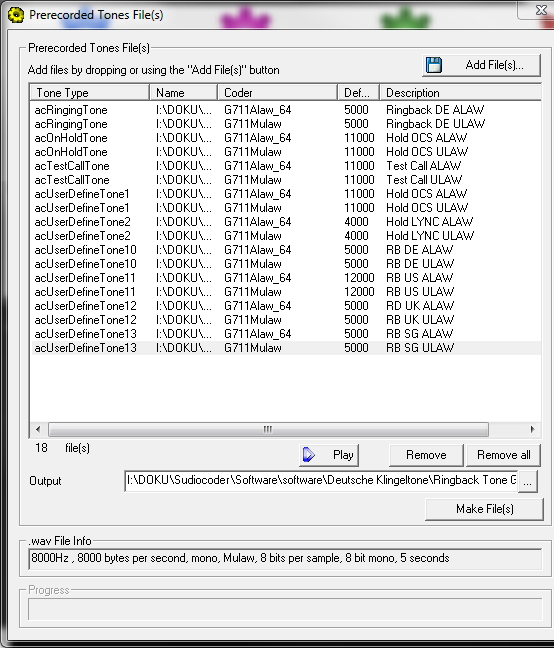Uploading a Prerecorded Tones File
The Prerecorded Tones (PRT) file can contain up to 80 user-defined prerecorded tones (and up to 10 minutes of recorded audio in total) that can be played by the device. The PRT file overcomes the limitations of the CPT file (such as limited number of predefined tones and limited number of frequency integrations in a single tone).
Some usage examples of the PRT file include:
|
■
|
Playing a held tone (music on hold) to a call party that has been put on hold, or playing a ringback tone to a calling party. |
|
■
|
Playing different held and ringback tones to different groups of users. To do this, configure an IP Profile (see Configuring IP Profiles) with the desired ringback tone ('Local Ringback Tone Index' parameter) and/or held tone ('Local Held Tone Index' parameter), and then associate the IP Profile with the desired IP Group. |
|
●
|
The PRT file only generates (plays) tones; detection of tones is according to the CPT file. |
|
●
|
The PRT file can be up to 4 megabytes in size. |
|
●
|
If the PRT file contains a tone that also exists in the CPT file, the tone in the PRT file is played instead (i.e., overrides the tone in the CPT file). |
|
●
|
For SBC calls, you can define a PRT file with multiple tones for the same tone type, but where each tone is defined with a different coder. If the coder of the tone is the same as that used in the current call, DSPs are not required by the device to play the tone. Therefore, if a tone is defined with a coder that is also used in the call, the device always selects this specific tone. However, if the coders are different, the device uses DSPs to play the appropriate tone from the Call Progress Tones (CPT) file (if the tone and CPT file exist). |
|
●
|
Local generation of tones is not supported.
|
|
●
|
The PRT file supports only the ringback tone and hold tone for SBC calls.
|
You can record the tones using a standard third-party, recording utility. You need to record the tones (raw data files) with the following properties:
|
■
|
Coders: G.711 A-law, G.711 µ-law, or G.729 |
The PRT file can include prerecorded audio tones of different coders (e.g., some with G.711 and some with G.729). The prerecorded tones are played repeatedly. This allows you to record only part of the tone and then play the tone for the full duration. For example, if a tone has a cadence of 2 seconds on and 4 seconds off, the recorded file should contain only these 6 seconds. The device repeatedly plays this cadence for the configured duration. Similarly, a continuous tone can be played by repeating only part of it.
Once recorded, you need to combine the recorded files into a single and loadable PRT file (.dat), using the latest version of AudioCodes DConvert utility. In DConvert, each recording must be added to the PRT file with the tone type "acUserDefineTone<Index>". When you want to specify the tone (ringback or held tone) to play for a specific IP Profile ('Local Ringback Tone Index' and 'Local Held Tone Index' parameters), you need to use this index number. For more information on the DConvert utility, refer to the DConvert Utility User's Guide. Once you have created the PRT .dat file, you need to upload it to the device (flash memory).
The following figure shows an example of creating a PRT file with multiple user-defined tones ("acUserDefineTone<Index>"), using the DConvert utility:

|
➢
|
To upload a Prerecorded Tones file: |
|
2.
|
Under the Prerecorded Tones file group, click the Choose File button (or Browse button, depending on browser) to select the file from a folder on your computer, and then click Load File: |

|
3.
|
On the toolbar, click Save for your settings to take effect. |

